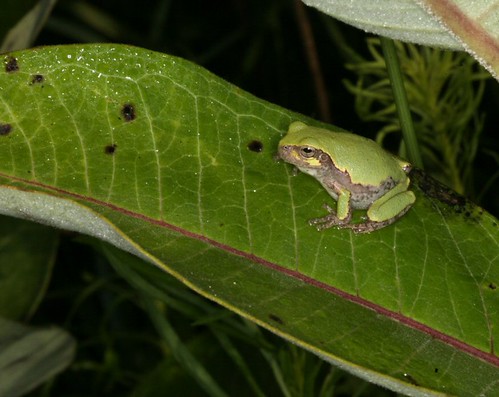tags: Gray Tree Frog, Hyla versicolor, Hyla chrysocelis, Image of the Day
Here is today's pic, a Gray Tree Frog, from Konza Prairie in eastern Kansas. There are two species of Gray Tree Frog, Hyla versicolor and Hyla chrysocelis, which look identical and can only be distinguished by their call. This one wasn't calling... It is also not grey; these frogs have the ability to change color, from gray to brown to green, depending on their surroundings and ambient temperature, humidity, etc.
This one was sitting quietly on a milkweed leaf, trying to look as green as possible.
Image: David A. Rintoul, KSU [larger]
More information below the fold ..
There are two species of gray tree frogs; the gray tree frog, Hyla versicolor, is sometimes referred to as the North American common tree frog, and Cope's gray tree frog, Hyla chrysocelis. These two species can only be distinguished by their voices; Cope's has a faster paced, and slightly higher pitched call than H. versicolor.
Even though the gray tree frogs' name implies that they remains the same color all the time, this is absolutely not true. In fact, some people describe these frog species as the chameleons of the frog world because of their remarkable ability to change colors to match their environment.
These medium-sized amphibians are common throughout much of the southern United States, but have been found as far north as the Canadian provinces of New Brunswick and Manitoba. They are highly arboreal as their name implies, and their preferred habitat consists of shallow water located close to mixed stands of willows, oaks and pines. These frogs also prefer dense overhead vegetation, along with fallen branches or extensive vegetation along the water's edge, and they typically congregate in brushy, overgrown areas.
During the day, gray tree frogs hide on or beneath rough tree bark, in hollow trees or on leaves. They tolerate high temperatures well, and they're most active during the summer, when humidity is high. Gray tree frogs are opportunistic feeders that eat mostly insects, spiders and other invertebrates.
These frogs breed from early spring through the end of July. Males attract females using a song that has been described variously as either like birdsong or buzzing trills [Cope's gray tree frog; wav]. Males begin calling in groups at breeding sites when night air temperatures reach 60 degrees. Each female produces between 700 and 3,800 tiny light brown eggs, which are deposited in water where they stick to floating vegetation in clumps of ten to forty eggs. Five days later, the eggs have hatched and the tadpoles metamorphose into the adult frogs two months later.
Frogs demonstrate the remarkable ability to climb or rest on vertical surfaces. This is the result of a mucous layer produced by their toe pad cells. This mucous creates a sticky bond with the vertical surface that's strong enough to support the frog's weight.
More information
Sounds of North American Frogs free download.

